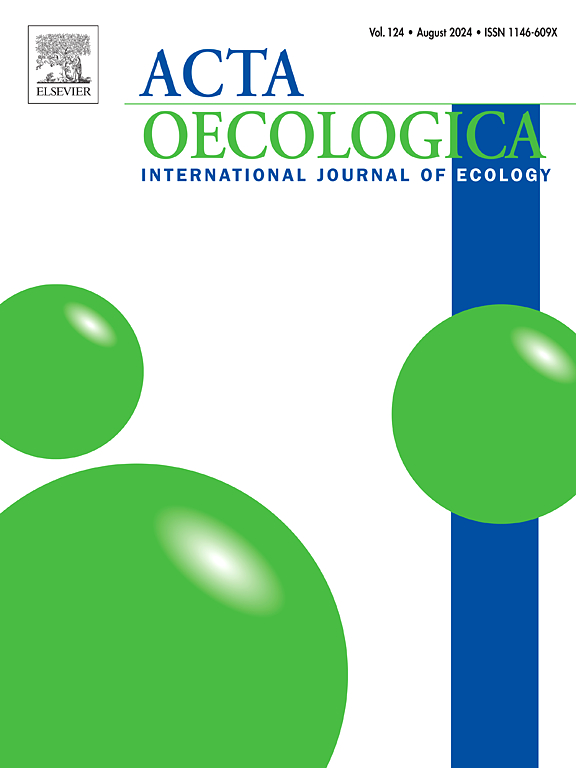南美地下生物多样性新热点无脊椎动物群落形成因素及生境选择
IF 1.3
4区 环境科学与生态学
Q3 ECOLOGY
Acta Oecologica-International Journal of Ecology
Pub Date : 2024-12-02
DOI:10.1016/j.actao.2024.104043
引用次数: 0
摘要
洞穴是研究形成生物群落的环境因素的特殊生态模型。然而,对于这些环境因素如何影响同一洞穴系统中群落的分布和对栖息地特征的响应,人们的探索有限。为了解决这一差距,我们在位于巴西半干旱地区的一个石灰岩洞穴(Pedro Cassiano洞穴)中采用了标准化的采样方法,跨越两个尺度。我们的目标是揭示基质特征和条件如何影响无脊椎动物(穴居动物和非穴居动物)的组成和丰富度的变化。此外,我们还试图了解一些穴居物种的生境选择。这个特殊的洞穴拥有丰富的动物群,有21种固定的洞穴物种(20种无脊椎动物和1种鱼类),这使它成为南美洲地下生物多样性(用于拥有20种或更多穴居动物物种的洞穴)的新热点。佩德罗卡西亚诺洞穴有两个独立的支流,从它的最后一部分流出,并合并成一个单一的排水系统,通过洞穴入口出口(复苏)。我们发现,独立分析各支流时,非穴居无脊椎动物丰富度的分布存在差异,表明地下物种的分布格局可能是复杂的。微生境特征,如异质性、沙的数量和营养资源的可用性,解释了该洞穴中无脊椎动物群落分布的重要部分,尽管这种影响依赖于规模。最后,我们强调了保护这个重要洞穴的紧迫性。本文章由计算机程序翻译,如有差异,请以英文原文为准。
Exploring the factors shaping the invertebrate community and habitat selection in a new Hotspot of Subterranean Biodiversity in South America
Caves serve as exceptional ecological models for studying the environmental factors that shape biological communities. However, there has been limited exploration into understanding how these environmental factors affect communities’ distribution and responses to habitat traits within the same cave system. To address this gap, we employed standardized sampling methodologies across two scales within a limestone cave located in the Brazilian semi-arid region (Pedro Cassiano cave). Our objective was to uncover how substrate characteristics and conditions may contribute to variations in the composition and richness of invertebrates (troglobitic and non-troglobitic). Furthermore, we aimed to comprehend the habitat selection of some troglobitic species. This particular cave hosts a rich fauna, with 21 obligate cave species (20 invertebrates and 1 fish), which positions it as new Hotspot of Subterranean Biodiversity (term used for caves that have 20 or more troglobitic species) in South America. Pedro Cassiano Cave has two separate tributary drainages that flow from its final section and merge into a single drainage system that exits through the cave entrance (resurgence). We observed that the distribution of non-troglobitic invertebrate richness differed when each tributary branch was analyzed independently, indicating that the distribution patterns of subterranean species can be complex. Microhabitat characteristics such as heterogeneity, the amount of sand, and the availability of trophic resources explained a significant portion of the invertebrate community distribution in this cave, although this influence was scale-dependent. Finally, we emphasized the urgency of conservation efforts for this important cave.
求助全文
通过发布文献求助,成功后即可免费获取论文全文。
去求助
来源期刊
CiteScore
3.60
自引率
0.00%
发文量
57
审稿时长
>0 weeks
期刊介绍:
Acta Oecologica is venue for the publication of original research articles in ecology. We encourage studies in all areas of ecology, including ecosystem ecology, community ecology, population ecology, conservation ecology and evolutionary ecology. There is no bias with respect to taxon, biome or geographic area. Both theoretical and empirical papers are welcome, but combinations are particularly sought. Priority is given to papers based on explicitly stated hypotheses. Acta Oecologica also accepts review papers.

 求助内容:
求助内容: 应助结果提醒方式:
应助结果提醒方式:


